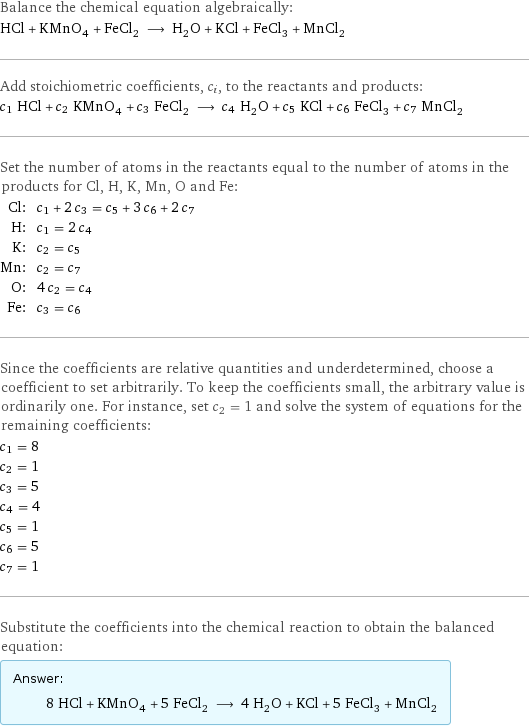Input interpretation

HCl (hydrogen chloride) + KMnO_4 (potassium permanganate) + FeCl_2 (iron(II) chloride) ⟶ H_2O (water) + KCl (potassium chloride) + FeCl_3 (iron(III) chloride) + MnCl_2 (manganese(II) chloride)
Balanced equation

Balance the chemical equation algebraically: HCl + KMnO_4 + FeCl_2 ⟶ H_2O + KCl + FeCl_3 + MnCl_2 Add stoichiometric coefficients, c_i, to the reactants and products: c_1 HCl + c_2 KMnO_4 + c_3 FeCl_2 ⟶ c_4 H_2O + c_5 KCl + c_6 FeCl_3 + c_7 MnCl_2 Set the number of atoms in the reactants equal to the number of atoms in the products for Cl, H, K, Mn, O and Fe: Cl: | c_1 + 2 c_3 = c_5 + 3 c_6 + 2 c_7 H: | c_1 = 2 c_4 K: | c_2 = c_5 Mn: | c_2 = c_7 O: | 4 c_2 = c_4 Fe: | c_3 = c_6 Since the coefficients are relative quantities and underdetermined, choose a coefficient to set arbitrarily. To keep the coefficients small, the arbitrary value is ordinarily one. For instance, set c_2 = 1 and solve the system of equations for the remaining coefficients: c_1 = 8 c_2 = 1 c_3 = 5 c_4 = 4 c_5 = 1 c_6 = 5 c_7 = 1 Substitute the coefficients into the chemical reaction to obtain the balanced equation: Answer: | | 8 HCl + KMnO_4 + 5 FeCl_2 ⟶ 4 H_2O + KCl + 5 FeCl_3 + MnCl_2